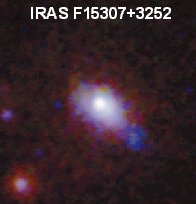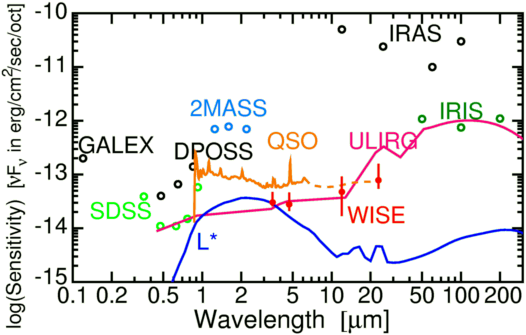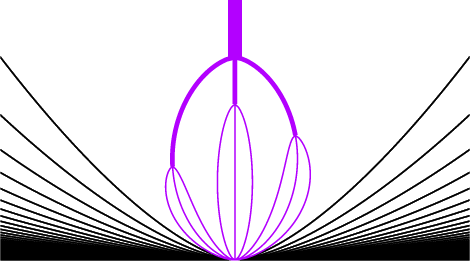WISE and Ultra-Luminous IR Galaxies
IRAS discovered a class of galaxies which are as much as 100 times
more luminous in the IR than in visible light, rivaling quasars in
total luminosity.
These ULIRG's are found in merging galaxies whose collisions lead to
dust-enshrouded bursts of star formation.
WISE will find ULIRG's all over the sky, out to distances and lookback
times where most galaxies were still forming.
 The hyperluminous IR galaxy F15307+3252 at z = 0.93 was discovered
by WISE science team member Roc Cutri in the IRAS Faint Source Catalog.
The image at right shows a NICMOS near IR picture of this object taken by
Dean Hines and Frank Low.
WISE will be sensitive enough to detect hyperluminous IR galaxies like
F15307+3252 at a redshift of 3. Since this is beyond the peak of the
star formation vs. redshift curve [Madau], it is likely that WISE
will see the most luminous IR galaxy in our obserable Universe.
The hyperluminous IR galaxy F15307+3252 at z = 0.93 was discovered
by WISE science team member Roc Cutri in the IRAS Faint Source Catalog.
The image at right shows a NICMOS near IR picture of this object taken by
Dean Hines and Frank Low.
WISE will be sensitive enough to detect hyperluminous IR galaxies like
F15307+3252 at a redshift of 3. Since this is beyond the peak of the
star formation vs. redshift curve [Madau], it is likely that WISE
will see the most luminous IR galaxy in our obserable Universe.

The flux of the IRAS Faint Soruce Catalog object F15307+3252 moved to a
redshift of 3 in a cosmological model with a cosmological constant
as is favored by the recent SNe Ia data, compared to the WISE
sensitivities.
A z=1 L* galaxy is also shown, along with an IR extrapolation of the
z=6.3 SDSS QSO.
Data taken in the sub-mm where dust extinction is not important, or
optical data corrected for extinction, suggest that there may not be a
peak in the Madau curve. However, it is still expected that the objects
that collapse early in the history of the Universe will be low mass, and
that the massive galaxies seen today will be generated in mergers of
these fragments, as shown in the space-time diagram below:

In any case, the only way to find the most luminous IR galaxy in the
observable Universe is to search the whole sky, and the WISE sensitivity
vs. wavelength is well matched to the spectrum of these objects.
WISE Home Page
Last modified 26-Feb-2003
 The hyperluminous IR galaxy F15307+3252 at z = 0.93 was discovered
by WISE science team member Roc Cutri in the IRAS Faint Source Catalog.
The image at right shows a NICMOS near IR picture of this object taken by
Dean Hines and Frank Low.
WISE will be sensitive enough to detect hyperluminous IR galaxies like
F15307+3252 at a redshift of 3. Since this is beyond the peak of the
star formation vs. redshift curve [Madau], it is likely that WISE
will see the most luminous IR galaxy in our obserable Universe.
The hyperluminous IR galaxy F15307+3252 at z = 0.93 was discovered
by WISE science team member Roc Cutri in the IRAS Faint Source Catalog.
The image at right shows a NICMOS near IR picture of this object taken by
Dean Hines and Frank Low.
WISE will be sensitive enough to detect hyperluminous IR galaxies like
F15307+3252 at a redshift of 3. Since this is beyond the peak of the
star formation vs. redshift curve [Madau], it is likely that WISE
will see the most luminous IR galaxy in our obserable Universe.

